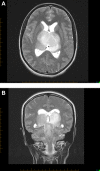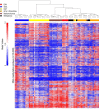Bithalamic gliomas may be molecularly distinct from their unilateral high-grade counterparts
- PMID: 28032389
- PMCID: PMC5489374
- DOI: 10.1111/bpa.12484
Bithalamic gliomas may be molecularly distinct from their unilateral high-grade counterparts
Abstract
Bithalamic gliomas are rare cancers diagnosed based on poorly defined radiologic criteria. Infiltrative astrocytomas account for most cases. While some previous studies reported dismal outcomes for patients with bithalamic gliomas irrespective of therapy and histologic grade, others described better prognoses even without anticancer therapy. Little is known about their molecular characteristics. We reviewed clinical, radiologic, and histologic features of patients with bithalamic gliomas treated at our institution over 15 years. Targeted sequencing of mutational hotspots in H3F3A, HIST1H3B, IDH1/2, and BRAF, and genome-wide analysis of DNA methylation and copy number abnormalities was performed in available tumors. Eleven patients with bithalamic gliomas were identified. Their median age at diagnosis was 4.8 years (range: 1-15.7). Additional involvement of the brainstem, basal ganglia, and cerebral lobes occurred in 11, 9, and 3 cases, respectively. All patients presented with hydrocephalus. Two-thirds of the patients had a histologic diagnosis of anaplastic astrocytoma. Despite aggressive therapy, our youngest patient, the only one diagnosed before 1 year of age, is the sole long-term survivor. DNA methylation could be performed in seven tumors, all of which clustered with the RTK I 'PDGFRA' subgroup by unsupervised hierarchical analysis of methylation array against a previously published cohort of 59 pediatric high-grade gliomas. Sequencing of hotspots mutations could be done in 10 tumors, none of which harbored H3F3A p.K27 and/or the respective DNA methylation signature, and any other hotspot mutations. Amplification of MDM4 (n = 2), PDGFRA (n = 2), and ID2 combined with MYCN (n = 1) were observed in 7 tumors available for analysis. In comparison with the previously published experience with unilateral high-grade thalamic astrocytomas where H3F3A p.K27 was present in two-thirds of cases, the absence of this molecular subgroup in bithalamic gliomas was striking. This finding suggests that unilateral and bithalamic high-grade gliomas may represent two distinct molecular entities.
Keywords: bithalamic; children; high-grade glioma; infiltrative; molecular characteristics.
© 2016 International Society of Neuropathology.
Conflict of interest statement
The authors have no conflicts of interest to disclose related to this manuscript.
Figures




Similar articles
-
Gliomatosis cerebri in children shares molecular characteristics with other pediatric gliomas.Acta Neuropathol. 2016 Feb;131(2):299-307. doi: 10.1007/s00401-015-1532-y. Epub 2016 Jan 7. Acta Neuropathol. 2016. PMID: 26744350 Free PMC article.
-
Pediatric thalamic tumors in the MRI era: a Canadian perspective.Childs Nerv Syst. 2016 Feb;32(2):269-80. doi: 10.1007/s00381-015-2968-z. Epub 2015 Nov 23. Childs Nerv Syst. 2016. PMID: 26597682
-
Characterizing temporal genomic heterogeneity in pediatric high-grade gliomas.Acta Neuropathol Commun. 2017 Oct 30;5(1):78. doi: 10.1186/s40478-017-0479-8. Acta Neuropathol Commun. 2017. PMID: 29084603 Free PMC article.
-
Targeting Epigenetic Pathways in the Treatment of Pediatric Diffuse (High Grade) Gliomas.Neurotherapeutics. 2017 Apr;14(2):274-283. doi: 10.1007/s13311-017-0514-2. Neurotherapeutics. 2017. PMID: 28233220 Free PMC article. Review.
-
Pediatric brain tumors: the era of molecular diagnostics, targeted and immune-based therapeutics, and a focus on long term neurologic sequelae.Curr Probl Cancer. 2021 Aug;45(4):100777. doi: 10.1016/j.currproblcancer.2021.100777. Epub 2021 Jul 16. Curr Probl Cancer. 2021. PMID: 34303558 Review.
Cited by
-
Adult H3K27M mutated thalamic glioma patients display a better prognosis than unmutated patients.J Neurooncol. 2022 Feb;156(3):615-623. doi: 10.1007/s11060-022-03943-7. Epub 2022 Jan 7. J Neurooncol. 2022. PMID: 34994963
-
Novel therapeutic approaches for pediatric diencephalic tumors: improving functional outcomes.Front Oncol. 2023 Oct 10;13:1178553. doi: 10.3389/fonc.2023.1178553. eCollection 2023. Front Oncol. 2023. PMID: 37886179 Free PMC article. Review.
-
MRI-based diagnosis and treatment of pediatric brain tumors: is tissue sample always needed?Childs Nerv Syst. 2021 May;37(5):1449-1459. doi: 10.1007/s00381-021-05148-1. Epub 2021 Apr 5. Childs Nerv Syst. 2021. PMID: 33821340 Free PMC article. Review.
-
Molecular and Pathological Features of Paediatric High-Grade Gliomas.Int J Mol Sci. 2024 Aug 3;25(15):8498. doi: 10.3390/ijms25158498. Int J Mol Sci. 2024. PMID: 39126064 Free PMC article. Review.
-
Spotlights on adult patients with pediatric-type diffuse gliomas in accordance with the 2021 WHO classification of CNS tumors.Front Neurosci. 2023 May 5;17:1144559. doi: 10.3389/fnins.2023.1144559. eCollection 2023. Front Neurosci. 2023. PMID: 37214395 Free PMC article.
References
-
- Bady P, Sciuscio D, Diserens AC, Bloch J, van den Bent MJ, Marosi C et al (2012) MGMT methylation analysis of glioblastoma on the Infinium methylation BeadChip identifies two distinct CpG regions associated with gene silencing and outcome, yielding a prediction model for comparisons across datasets, tumor grades, and CIMP‐status. Acta Neuropathol 124:547––560. - PMC - PubMed
-
- Bilginer B, Narin F, Işıkay I, Oguz KK, Söylemezoglu F, Akalan N (2014) Thalamic tumors in children. Childs Nerv Syst 30:1493––1498. - PubMed
MeSH terms
Grants and funding
LinkOut - more resources
Full Text Sources
Other Literature Sources
Medical
Research Materials
Miscellaneous

